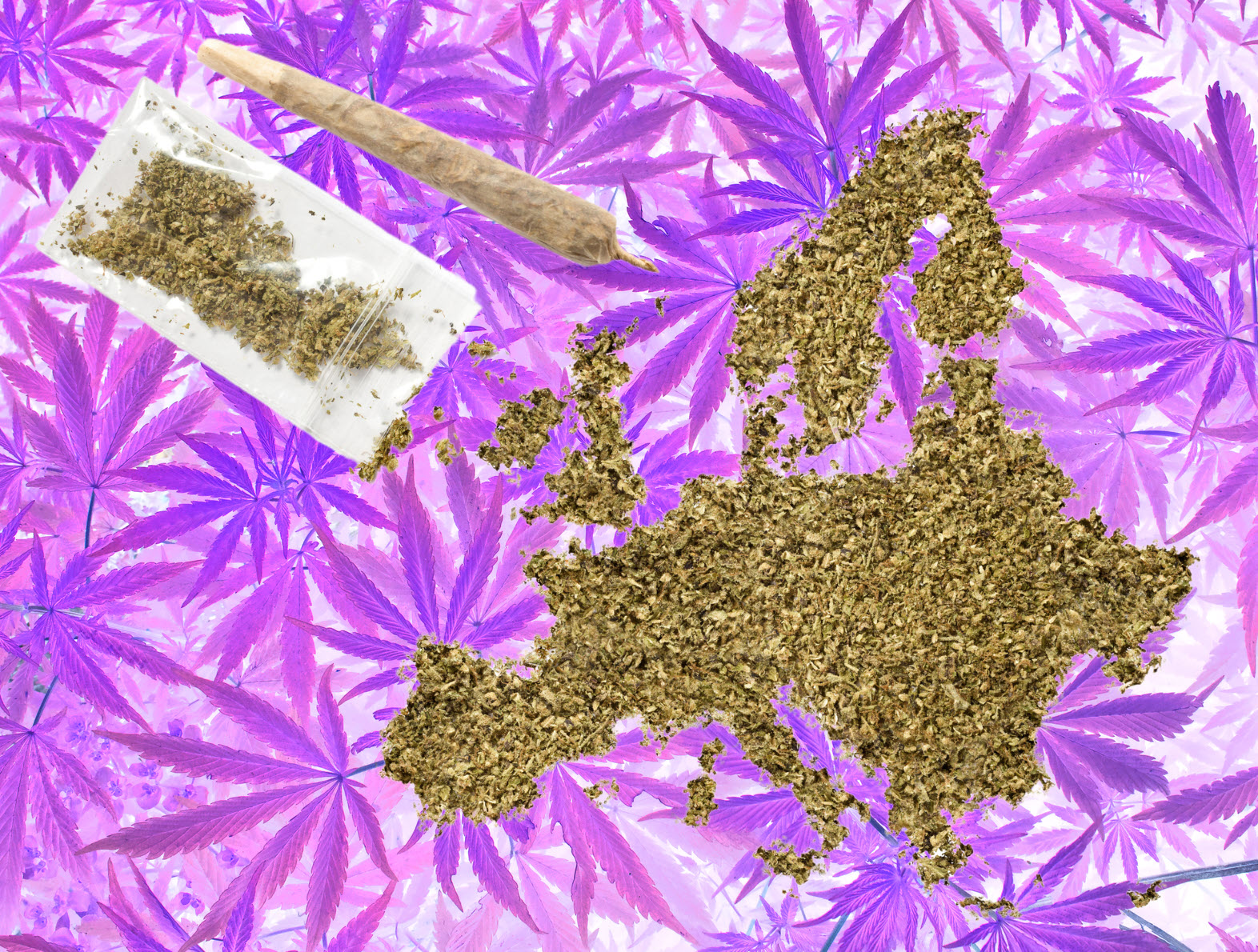Cannabis News
The European Cannabis Market – Are You Buying or Selling the Hype?
Published
1 year agoon
By
admin

Cannabis businesses are taking note across the Atlantic, where the grass appears greener. As the global cannabis business matures, Europe is emerging as a top location for entrepreneurs seeking to thrive in this thriving market. With its ever-changing legislative landscape and tremendous untapped potential, Europe presents a unique opportunity for cannabis growth and expansion.
In 2023 alone, the European cannabis market is estimated to be worth $8.47 billion, and projections suggest this figure could soar beyond $15 billion by 2027. These numbers highlight the continent’s unique potential and make it an attractive and highly lucrative prospect for innovative cannabis businesses. Entrepreneurs with ambition and foresight will have Europe at the forefront as they seek to tap into this new wave of growth and innovation.
The United States and Canada have traditionally been the go-to choices for many cannabis ventures. However, to advocate for Europe as the actual land of opportunity in the cannabis industry may be a go-to headline, but there is one big problem with thinking European cannabis will make investors tons of money. As Cannabis.net pointed out in a previous article called, “With a Gun to My Head Here is One Cannabis Idea to Go Long on and One Cannabis Idea to Go Short On?”, while Europe may turn out ot the biggest cannabis market in the world, legalization will also create the biggest illicit or black market in the world. With its promising market conditions, Europe is poised to become the focal point for ambitious entrepreneurs looking to make their mark in this exciting and rapidly expanding field. Those entreprenuers may be looking to create higher margins by joining the illicit market as opposed to the legal market.
As the article points out:
Go Short
This one may surprise you and goes against some of the brightest minds in the industry, but if I had to pick a short, I am going to short EU weed. What? That massive market? Don’t you read your own stuff on Cannabis.net saying the European cannabis market could be the biggest weed market on earth?
If you think the US black market is a problem and decimating the legal industry at every turn, considering you can get edibles on the black market for $0.07 on the $1.00 compared to the legal market, the EU version of this will be 10x worse.
Europe will face much bigger problems with black and illegal markets than the US or Canada for a few reasons. One, the 27-country union very rarely can agree on anything, let alone enforcement of anything. Two, you have members who are very “rich” like Germany and Switzerland, and members that are dirt poor, like ex-Soviet Union countries like Romania and Belarus. Hence, there is a natural incentive for the “poor” countries to cheat and try and make more money since they can’t compete with the Germany’s and Poland’s of the EU.
That is not to mention the poor countries of Northern Africa that sit in beautiful geographic regions to grow cannabis. Go check out where Tunisia, Libya, Algeria, Morocco, Sudan, Niger, and Chad sit on the climate zone map. They also have massive access to Europe to a variety of routes such as land, water, and air. If you think immigrants were a problem for Europe, wait until you see cannabis coming in by land, sea, and air.
Europe also has thousands of miles of borders by land and sea with a variety of poor countries. Basically, access points to Europe are 10x more abundant than the US and Mexican border.
History would pay a roll as well, if you followed the Euro crisis of a few years ago, it was Germany setting the rules and everyone else had to follow. There is ill will toward the northern, prosperous EU countries compared to the less productive southern European countries. It will be German legalization verse everyone else once cannabis gets rolling in the EU. The incentives financially to cheat and use the black market will be overwhelming for the residents of dirt-poor countries. The incentive to “do as Germany says” will fall on deaf ears regarding cannabis enforcement if every town mayor, immigration officer, and police chief if getting their share of the action.
Yes, the EU will be a massive cannabis market, but will also be susceptible to the largest illicit market on the planet. The EU having poor members and being surrounded by poor countries will help create high volume “weed corridors” of shipping and selling illegal cannabis.
Think California only x10. Instead of an ocean on one side of California, what would it look like if you put Haiti, Costa Rica, the Dominican Republic, and Brazil next to California as borders instead of the Pacific Ocean? That is pretty much what the EU is looking at as they try to create a unified cannabis industry with rules and enforcement.
Making money in cannabis is a long game, sit tight, watch legalization and import/export numbers from around the world to get a feel on who will win and who will lose in the international weed game.
Europe’s potential in the cannabis industry reaches towering heights like the Eiffel Tower. It’s high time for cannabis businesses to embrace this promising continent fully. The diverse legal landscape and ever-evolving regulatory environment create a fertile ground for substantial growth, but that growth will be 2x higher for the illegal market as well.
Moreover, the relatively untapped market presents an alluring alternative to the saturated North American scene. Let’s delve into why Europe stands as the perfect playground for ambitious cannabis entrepreneurs who decide to go legit or illicit in their attemps to join the industry.
A Solid Foundation in Europe
The United States boasts several states where cannabis has been legalized, yet it grapples with federal-level illegality, leading to a complex and uncertain banking landscape. This dichotomy has presented considerable challenges for cannabis enterprises, forcing them to navigate cautiously through federal regulations, resulting in a heavy reliance on cash transactions and limited access to loans and financial services.
In contrast, the European Union has taken a more progressive stance, enacting policies that actively cater to the banking requirements of the cannabis industry. By providing a well-established and accommodating financial framework, European cannabis businesses have enjoyed a more stable platform for growth and expansion. This advantageous environment has encouraged innovation, investment, and entrepreneurial ventures within the EU’s cannabis sector.
Europe Offers Huge Consumer Base
Europe stands out as a lucrative market with its staggering population of over 740 million people, presenting an unparalleled consumer base ready to be harnessed. In contrast, the combined populations of the United States and Canada hover around 360 million, underscoring Europe’s vast opportunity for businesses in the cannabis industry. As more European countries progressively legalize or decriminalize cannabis, the potential for market expansion becomes even more promising.
The evolving attitudes toward cannabis in various European nations allow businesses to tap into new markets, driving innovation and entrepreneurial ventures. This changing regulatory landscape fosters an environment conducive to promoting cannabis-related enterprises and attracting substantial investments.
Moreover, the diverse cultures and economies across the continent present a unique and exciting challenge for industry players, prompting tailored strategies and approaches to cater to the preferences and demands of European consumers.
Strategic Location for Import and Export
Europe’s central geographic location and its extensive network of well-established trade routes have positioned it as a hub for cannabis import and export, offering unparalleled opportunities for businesses in the industry. As cannabis regulations continue to evolve across the continent, Europe has emerged as a pivotal player, connecting global markets in Africa, Asia, and the Middle East.
The strategic advantage of being a central cannabis trading hub grants European companies access to a vast and diverse customer base, fueling international collaborations and partnerships. This unique position has proven to be a desirable asset that U.S.-based companies can only envision from afar. The legal complexities and federal restrictions surrounding cannabis in the United States have hindered its businesses’ ability to fully capitalize on international trade opportunities in the same way European enterprises can.
By capitalizing on its prime location, Europe can facilitate the seamless movement of cannabis products across borders while adhering to evolving regulatory frameworks. This interconnectedness fosters a thriving global cannabis market and presents European companies with a significant competitive edge in the ever-expanding cannabis industry. As the trade landscape evolves, Europe’s influence will likely grow, reinforcing its status as a central force in the international cannabis trade arena.
Diverse Market Landscape
The cannabis landscape in Europe offers a rich tapestry of opportunities, ranging from the iconic coffee shops in Amsterdam to the progressive medical cannabis clinics in Germany and beyond. This dynamic range of market structures and regulatory frameworks creates a fertile ground for businesses to customize their strategies and cater to specific niches within the continent’s diverse consumer base.
As the cannabis industry in Europe continues to mature and evolve, forward-thinking entrepreneurs are presented with a golden chance to establish targeted brands that deeply resonate with the region’s multifaceted cultures.
Each country’s unique approach to cannabis presents distinct challenges and prospects for market entry and expansion. Adapting to the varying legal landscapes, cultural preferences, and consumer behaviors allows businesses to carve out their niches and establish a strong foothold in specific European markets.
Conclusion
Europe provides a distinct and promising landscape for cannabis entrepreneurs. With its continuously evolving regulations, diverse market conditions, and strategic geographical position, the continent holds a vast reservoir of untapped potential. If you’re a cannabis entrepreneur with ambitious goals, it might be the perfect time to consider venturing into Europe’s promising opportunities. If you are an investor, “buyer beware” as you will be competing with weak borders and poor countries surrounding the “golden goose” continent.
EUROPEAN CANNABIS MARKETS, READ ON…
IS EUROPE THE BIGGEST CANNABIS MARKET IN THE WORLD?
You may like
-


Karma Koala Podcast 247: Speaking with Dr. Natalie Corthésy senior lecturer university of West Indies & Enrico Bonadio professor of law City St George’s University of London about their forthcoming Edward Elgar title, “Intellectual Property and Cannabis”
-


MJBizCon offers speakers chance to share cannabis insights, shape industry
-


The Best Tariff Friendly Cocktails
-


Cannabis Consumers Are Being Hit By The Tariffs
-


The Best Tips To Update Your Wardrobe
-


Former New York Knick Iman Shumpert debuts ‘TSA Approved’ legal cannabis brand
Cannabis News
Scientists Now Think That One Compound in the Cannabis Plant Can Replace All Opiates
Published
2 days agoon
April 3, 2025By
admin

Which Cannabis Compound Do Scientists Think Can Replace Opiates?
…And Why This Is Important
Opiates are a type of pharmaceutical drug that’s been made from the opium poppy plant. While it’s somewhat a ‘natural’ substance that’s been extracted from the fibers and sap of the opium poppy plant, these are extremely dangerous sedatives that act on the central nervous system. However, there are completely synthetic opioids as well, which are manufactured entirely in laboratories.
Famous examples of well-known and widely-used opiates today include heroin, codeine, and morphine. They all work similarly, binding to the brain’s opioid receptors and users feel a drastic reduction in pain. It also causes users to feel euphoric, drowsy, or sleepy. Common side effects include constipation and nausea.
Because opiates are powerful for dulling one’s pain perceptions, they have become commonly prescribed by doctors and hospitals for pain relief. That said, opiates have become one of the world’s most addictive, dangerous, and fatal drugs – and you can get prescribed it right by your very own physician. Repeated use of opiates can easily lead to dependence and addiction, and eventually consuming high doses can drastically slow down breathing, and cause brain damage, or even death.
Since doctors still keep prescribing opioids, this has resulted in the deadly Opioid Epidemic, which has killed thousands of people. It’s a worrisome public health crisis, most especially because of fentanyl, an illegally manufactured opioid which is said to be 50 times more potent than heroin.
Could The Answer To The Opioid Epidemic Lie In Cannabis…Terpenes?
The past few years have shown that cannabis legalization is critical for surviving the opioid epidemic, and reducing overall opioid consumption.
The results of a recent research paper, which builds on past studies conducted by Dr. John Streicher, who is a member of the Comprehensive Center for Pain and Addiction, reveals fascinating findings. According to Streicher, cannabis terpenes were found to provide relief in inflammation models as well as on neuropathic pain caused by chemotherapy.
For the study, Streicher and his research team analyzed 4 kinds of terpenes that are found in mid to high levels in Cannabis sativa plants: linalool, geraniol, beta-caryophyllene, and alpha-humulene. They discovered that each terpene produced significant pain relief among mice subjects with fibromyalgia and post-operative pain, and among the terpenes, geraniol was found to be the most powerful.
“Our research is showing that terpenes are not a good option for reducing acute pain resulting from an injury, such as stubbing your toe or touching a hot stove; however, we are seeing significant reductions in pain when terpenes are used for chronic or pathological pain,” he said. “This study was the first to investigate the impact of terpenes in preclinical models of fibromyalgia and post-operative pain and expand the scope of potential pain-relieving treatments using terpenes,” Streicher said.
Cannabis terpenes are the compounds responsible for the aromatic profile of each strain; they are located in the plant trichomes. Not only do they contribute to each strain’s unique flavor and odor, but they also have valuable therapeutic and medicinal benefits. There are around 150 kinds of terpenes known today, though in the entire plant world, there are known to be some 20,000 terpenes.
Understanding the therapeutic benefits of terpenes is incredibly valuable also because they don’t contain THC (tetrahydrocannabinol), the compound in marijuana that gets you high.
“With fibromyalgia, there isn’t much of an understanding of what the pain state is, and there are not a lot of great options for treating it,” explains Streicher. “Our findings show that terpenes may be a viable treatment option for fibromyalgia pain, which could potentially have a large impact and make a difference for an under-treated population.”
Other Studies
This is not the first time that cannabis terpenes have been found to demonstrate excellent pain-relieving properties. It must be noted that just like what Streicher says, terpenes seem to do better with chronic pain management, instead of acute pain management.
Another study from 2024, which was published in The Journal of the Association for the Study of Pain, was conducted by researchers at the University of Arizona and the National Institutes of Health. The investigators analyzed the analgesic properties of different terpenes including geraniol, humulene, linalool, pinene, and caryophyllene among mice subjects with chemotherapy-induced peripheral neuropathy.
According to the researchers, all the terpenes delivered analgesic effects that were equivalent to around 10 mg/kg of morphine. It was also interesting to note that administering both morphine and terpenes together at low doses resulted in ‘enhanced’ pain-killing effects.
“Together these studies identify cannabis terpenes as potential therapeutics for chronic neuropathic pain,” said the investigators.
There have also been other studies that have found that combining cannabis with opioids can indeed provide long-lasting pain relief. It comes with the added benefit of reducing opioid doses needed for effective pain control. This phenomenon is called opioid-sparing. These types of protocols can be beneficial for patients who suffer from severe, chronic pain caused by cancer, arthritis, joint problems, fibromyalgia, diabetes, post-surgical pain, migraines, nerve damage, and so much more.
Conclusion
Learning more about the pain-killing properties of terpenes is extremely valuable for the medical community, patients, and even society as a whole. We can all do with less opioid addictions because it has torn families apart, and caused the deaths of thousands of people.
Terpenes, or cannabis in general, offer a natural and safe alternative that can be complementary to other pharmaceutical treatments designed to reduce pain.
SWAPPNG OPIOIDS FOR CANNABIS, READ ON…


Cannabis and the Authoritarian State
Cannabis has been legal for longer than it has been illegal. Let that sink in for a minute. For thousands of years, humans cultivated and consumed cannabis freely across civilizations and continents. It wasn’t until the early 1900s that we witnessed a massive push to drive hemp and cannabis into the black market, primarily due to industrial competition from petrochemicals, pharmaceuticals, and other industrial applications.
What makes cannabis so threatening to powerful interests? For starters, hemp and cannabis are highly versatile crops with over 50,000 different uses, from medicine to textiles to fuel. Even more remarkable is how this plant is hardwired to work with the human body through our endocannabinoid system—a biological network we didn’t even discover until the 1990s.
Perhaps most threatening of all is that cannabis is insanely easy to grow. This means that if the plant helps you with a particular physical ailment, you have the ability to grow your own medicine indefinitely. No insurance premiums, no wait lists, no pharmaceutical middlemen—just you cultivating your own healing directly from the earth.
Authoritarians do not like this, not one bit. When people can meet their own needs independently, power structures lose their grip. When citizens can think differently without permission, control systems begin to fail. So today, we’re going to look at the interesting relationship between authoritarianism and cannabis, and how this humble plant plays a key role in keeping you free.
We’ve already established the versatility of cannabis, but there’s another element that those old D.A.R.E. PSAs inadvertently reveal about what authoritarians think about cannabis. I’m talking, of course, about “behavior.” You see, in an authoritarian system, you and I are but cogs in the machine. We’re the expendables who should be proud to work ourselves to death for our “fearless leaders.”
This is precisely why certain ideas, philosophies, religions, movements, books, and substances are typically banned in authoritarian regimes. Take North Korea as an example: everything from the type of television citizens watch to the music they hear is a tightly spun spell designed to keep the populace in check. While they don’t have explicit laws against hemp (they actually grow it industrially), smoking psychoactive cannabis is strictly forbidden.
Contrast this with places like Malaysia, where you can get up to 5 years for possessing just 20 grams of cannabis, and even face the death penalty depending on the situation. These authoritarians don’t play around when it comes to cannabis because they know it affects the behavior of their populace in ways they can’t control.
The question becomes: what behavior do they fear so much that cannabis produces within the individual?
The answer is a critical mind. People who consume cannabis often begin to question their own belief systems. Most regular users undergo some transformation in their values and perspectives. Cannabis has a unique way of helping people see beyond cultural programming and think outside established paradigms. It can make the familiar strange and the strange familiar—a psychological state that’s antithetical to authoritarian control.
This independent thinking runs counter to the narrative of authoritarians who wish to maintain a tight grip on social consciousness. If even 10% of a population begins to pivot in their behavior within a regime, it can have massive ripple effects. Just look at cannabis in the US—it went from being demonized to being embraced by the majority in less than 80 years, despite massive propaganda efforts.
For authoritarians, psychoactive cannabis isn’t primarily a threat to public health and wellbeing—it’s a threat to the health and wellbeing of authoritarianism itself. When people start thinking differently, they start living differently. When they start living differently, they start demanding different. And that’s the beginning of the end for any system built on unquestioning obedience.
Beyond the threat to thought control, there’s another reason why drugs in general remain illegal: the state can use prohibition as a weapon against the populace. This isn’t conspiracy theory—it’s documented history.
Take Nixon’s war on drugs. His domestic policy chief, John Ehrlichman, later admitted: “We knew we couldn’t make it illegal to be either against the war or black, but by getting the public to associate the hippies with marijuana and blacks with heroin, and then criminalizing both heavily, we could disrupt those communities.” Nixon essentially placed cannabis on the Controlled Substances Act because he needed an excuse to shut down anti-war protests and target Black communities.
Since hippies and anti-war protesters were smoking “freedom grass,” making it illegal would circumvent their freedom of speech and freedom of assembly, and more importantly—turn free citizens into state property. It’s a win-win if you’re an authoritarian looking to silence dissent.
Then there’s the whole “boogeyman” complex that prohibition creates. We’re told “drug dealers” are roaming the streets preying on innocents, giving them “marihuanas” so they can do vile things. What the government conveniently leaves out is how the banks these “dealers” use to launder their money remain untouched. They don’t mention the shadier dealings of law enforcement either—like running guns into Mexico (eventually leading to the death of one of their own), or spraying poison on crops, killing and hospitalizing people because, you know…”Drugs are bad!”
Authoritarians cannot let go of the value that keeping the most widely used illicit substance in the world illegal provides them. This explains why the US hasn’t federally legalized cannabis despite nearly 80% of Americans supporting some form of legalization. It’s not because they don’t have enough research or that they’re genuinely concerned about public health—it’s because prohibition gives them all the privileges of violating constitutional rights while siphoning money into their coffers.
Drug prohibition creates a perpetual enemy that can never be defeated, allowing endless justification for surveillance, militarized police, asset forfeiture, and expansion of state power. What authoritarian could resist such a convenient tool?
Cannabis is a plant. You can’t make nature illegal—it’s counter to the human experience. When governments attempt to criminalize a naturally occurring organism that humans have cultivated and used for thousands of years, they reveal the absurdity of their position and the limits of their authority.
While the United States isn’t a full-on authoritarian state (yet), the truth is that many authoritarian elements have played out over the years. You only need to look as far as the war on drugs to see how the state utilizes prohibition as a weapon to their advantage. From no-knock raids to civil asset forfeiture to mass incarceration, drug laws have erected a parallel legal system where constitutional protections often don’t apply.
The fundamental truth is that cannabis is not only versatile and medicinal, it gives you back your autonomy in multiple ways. It helps you think for yourself. It allows you to grow your own medicine. It connects you with a plant that humans have used ceremonially, medicinally, and industrially throughout our history. And this autonomy is something authoritarians cannot stand—free individuals who know how to think beyond the narratives they’re fed.
Cannabis doesn’t just get you high—it offers a perspective from which the absurdities of prohibition become glaringly obvious. Perhaps this is why, as state after state legalizes, we’re witnessing the slow but steady unraveling of one of the most enduring authoritarian policies in American history.
So if you count yourself among those who value freedom of thought and bodily autonomy, who believe that nature doesn’t require government permission, and who understand that true liberty includes the right to explore your own consciousness—well, maybe it’s time to toke one up for freedom!
LEGALIZING CANNABIS IS NOT ENOUGH, READ ON..
Cannabis News
Stop Using Bat Poop to Fertilize Your Weed Plants Immediately, Here is Why…
Published
4 days agoon
April 1, 2025By
admin

Don’t Fertilize Your Weed with Bat Poop
Fertilization is a critical step for growing healthy marijuana plants.
They help provide essential nutrients for marijuana in various stages of growth, while promoting plant growth. There are dozens of different fertilizers to choose from in the market; growers can choose based on budget, nutrients needed, location, season, and much more. But not all fertilizers are made equally – of course, some are of better quality than others.
That said, there are some rather unusual fertilizers that can be used on plants. These may include, but are not limited to: coffee, milk, grass clippings, banana peels, fish tank water, potato water, and even urine! Yes, it does sound strange, but to gardening enthusiasts, there is nutritional value to be found in each of these things, which can make them suitable fertilizers depending on the circumstances.
For example, grass clippings make excellent mulch and can provide potassium, nitrogen, and phosphorus. Urine is a potent source of nitrogen as well as phosphorus. Banana peels are rich in calcium, which is excellent for promoting root growth while helping supply oxygen to the soil.
But what about bat poop? Also known as guano, bat poop has been said to work as a plant fertilizer because it’s rich in nitrogen, potassium, phosphorus, and other nutrients. Unfortunately, using bat poop as a plant fertilizer can also be dangerous. So if you don’t really know what you are doing, bat poop as a fertilizer can be extremely risky.
Bat Poop Fertilizer Kills 2 NY Men
On December 2024, news of two men hailing from Rochester, New York, dying went viral.
The cause of death was dangerous fungus, in the bat poop that they were using to fertilize their marijuana plants. Both men grew their own marijuana plants for medical consumption, but unfortunately developed histoplasmosis after breathing toxic fungal spores from the guano.
One of the men was aged 59 years old; he bought bat poop online to use as fertilizer for his plants. Meanwhile, the other was a 64-year-old male who found guano in his attic, then decided to use it to fertilize his cannabis plants. They both developed similar symptoms, including chronic coughs, fever, severe weight loss, and respiratory failure. The case was also discussed in the Open Forum Infectious Diseases medical journal.
Is there a safe way to use bat poop as fertilizer? If you ask me, I truly can’t understand why one would use guano as fertilizer when there are so many other proven safe alternatives out there that are simply not as risky. According to the University of Washington, one must always wear a dust mask each time you open a bag containing soil amendments. That’s because a mask will greatly decrease the chances of breathing in fungal spores, which could be potentially dangerous. They also go on to explain that yes, guano is indeed used as fertilizer for its valuable nitrogen content but it still isn’t without its own risks, particularly of developing Histoplasma – the same condition that killed the two men.
Make Your Own Safe Fertilizers At Home
There are many other safe, affordable – and even free – fertilizers you can feed your marijuana plants with. It doesn’t have to cost a fortune nor does it have to be risky to your health.
Check out these easy, low-cost, DIY fertilizers for weed:
-
Coffee grounds are abundant in nitrogen, which makes it perfect for the vegetative stage of marijuana plants. They are also a fantastic source of organic materials and green waste, which contain other vital nutrients. When the coffee grounds decompose, they create soil aggregates that improve soil aeration and its water retention capabilities.
Mix around 2 grams of coffee ground for every liter of soil. Measuring its pH levels is also helpful, since you want it to be between 6 to 6.5
-
Crushed eggshells are a great way to ensure no eggshells go to waste. It’s rich in calcium plus other minerals that are effective in improving overall plant structure, health, and growth. In fact, so many gardeners and farmers commonly use crushed eggshells to help boost plant growth – and it will work just as well for marijuana plants.
They’re really easy to use, too! Just mix eggshells into the soil, or steep them into water then pour into the soil for a calcium-packed feed.
-
Banana tea or water is rich in potassium and magnesium, making it perfect as a feed during the marijuana plant’s flowering stage. You can use banana peels differently: with 3 to 5 banana peels, soak it in water for 2 days. Then you can use the water on your plants, and even leave the banana peels as compost for your garden.
-
Wood ash from your fireplace or other sources is a great source of phosphorus and potassium. Simply sprinkle some wood ash over marijuana during the final flower phase. Just use 1 or 2 grams of ash for every liter of substrate. Be careful not to use too much wood ash, or it can make the soil too alkaline.
-
Animal manure, such as those from cows, rabbits, or horses, make excellent organic fertilizers. Just be sure that they’re composed properly so that you avoid introducing weed seeds, or pathogens.
These low-cost fertilizers are also natural and effective. There’s no reason for you to turn to bat poop as fertilizer, even if you’re in a bind.
Conclusion
Guano or bat poop is a poor choice of fertilizer if you don’t know what you are doing. It’s risky and potentially dangerous – just not worth it. Instead, fertilize your marijuana plants with these options mentioned.
BEST POOP FOR CANNABIS PLANTS, KEEP READING…

Karma Koala Podcast 247: Speaking with Dr. Natalie Corthésy senior lecturer university of West Indies & Enrico Bonadio professor of law City St George’s University of London about their forthcoming Edward Elgar title, “Intellectual Property and Cannabis”

MJBizCon offers speakers chance to share cannabis insights, shape industry

The Best Tariff Friendly Cocktails

Cannabis Consumers Are Being Hit By The Tariffs

The Best Tips To Update Your Wardrobe

Former New York Knick Iman Shumpert debuts ‘TSA Approved’ legal cannabis brand

How New York pot pioneers made it to legal dispensary shelves

Scientists Now Think That One Compound in the Cannabis Plant Can Replace All Opiates

Vladimir Bautista is leading Happy Munkey’s legacy-to-legal takeover

Cannabis Can Help A Sore Throat

Distressed Cannabis Business Takeaways – Canna Law Blog™

United States: Alex Malyshev And Melinda Fellner Discuss The Intersection Of Tax And Cannabis In New Video Series – Part VI: Licensing (Video)

What you Need to Know

Drug Testing for Marijuana – The Joint Blog

NCIA Write About Their Equity Scholarship Program

It has been a wild news week – here’s how CBD and weed can help you relax

Cannabis, alcohol firm SNDL loses CA$372.4 million in 2022

A new April 20 cannabis contest includes a $40,000 purse

Your Go-To Source for Cannabis Logos and Designs

UArizona launches online cannabis compliance online course
Trending
-

 Cannabis News2 years ago
Cannabis News2 years agoDistressed Cannabis Business Takeaways – Canna Law Blog™
-

 One-Hit Wonders2 years ago
One-Hit Wonders2 years agoUnited States: Alex Malyshev And Melinda Fellner Discuss The Intersection Of Tax And Cannabis In New Video Series – Part VI: Licensing (Video)
-

 Cannabis 1012 years ago
Cannabis 1012 years agoWhat you Need to Know
-

 drug testing1 year ago
drug testing1 year agoDrug Testing for Marijuana – The Joint Blog
-

 Education2 years ago
Education2 years agoNCIA Write About Their Equity Scholarship Program
-

 Cannabis2 years ago
Cannabis2 years agoIt has been a wild news week – here’s how CBD and weed can help you relax
-

 Marijuana Business Daily2 years ago
Marijuana Business Daily2 years agoCannabis, alcohol firm SNDL loses CA$372.4 million in 2022
-

 California2 years ago
California2 years agoA new April 20 cannabis contest includes a $40,000 purse







